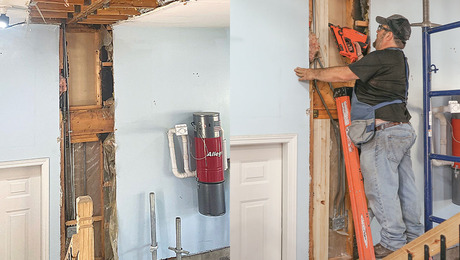That “2 hp” dc I have came with 14 ga wire into the switch and from switch to box on motor. Since it draws 22amps I find that pretty hard to believe. I have run it on a strong 20 A ckt. The plug is just a 15 a. I plan to rewire to 240 but am replacing the wire with some 12 and a 20a plug. How can they import something like that?
Discussion Forum
Discussion Forum
Up Next
Video Shorts
Featured Story

Don't buy in to the TV show nightmares—when you uncover something unforeseen on a remodeling project, take these steps to keep the process moving and fix the issue.
Featured Video
How to Install Exterior Window TrimHighlights
"I have learned so much thanks to the searchable articles on the FHB website. I can confidently say that I expect to be a life-long subscriber." - M.K.














Replies
What does the unit actually draw after start up? In other words what are the normal "running amps" required.
Measure this on your unit -- or is that the "22 amps" you refer to in your OP. Forget the initial start-up surge, even if you can measure it.
That 14ga may be just fine - I would not rip it out just yet.
Some of those alleged hp ratings are pretty squirrely.
Jim
Edited 7/19/2008 5:17 pm ET by JTC1
It was a running 22 amps, not startup. Using a cheap digital clamp-on. I have a couple of good old analog ampmeters but that sounds about right.
After looking more closely the 15A plug was made in Mexico which leads me to believe my BIL's ex partner may have put it on. No self respecting Chinaman would use a Mexican plug (:-).
The same way that they make similar stuff in the US.
If you look the unit is not UL approved. And IIRC there is no classification for such equipement except as industrial products and that would be very expensive.
But if you look most like the cordset is UL approved.
And the motor is UL approved.
But not the dust collector.
And the #14 flexable cord is rated for 18 or 20 amps depending on the
type of insulation
But something like that should never be used on a 15 amp circuit.
I am not concerned about the plug or receptacle. But the common time inverse breakers will carry a large overload for a long period of time.
Most WW equipment starts unloaded, except for interia, and only had peak loads for a short period of time as a board is being milled.
But a DC will draw near rated current, depending on the size and lenght of the ducts, for the whole time that it is on.
So change it over to 240 including replaceing the plug. But the cable is OK.
.
A-holes. Hey every group has to have one. And I have been elected to be the one. I should make that my tagline.
The cordset does not say anything about UL. It is printed "vctf 600v 37/0.26mm 2.0mm2 TA Huang (two symbols I do not recognize) 64009 1997". The wire from sw to motor says 14awg.
I already replaced the cordset with some older wire I had laying around. It reads "P.E.C.O 12/3 ST W-A". Put a quality plug on it and will temp run it on a single 20 amp ckt .
Plan to put that sub panel we were talking about in but instead of coming off the old fuse panel, going off the newer breaker panel. I have to look at it to see where I can shuffle a couple of circuits to get a dp breaker in. I used a lot of the half size breakers and need to recheck the "number of ckt" rating on the panel. Will probably move one or two of the basement ckts to the sub.
Thanks,Bob
Edited 7/19/2008 7:21 pm ET by rasconc
Update; I needed to cut a couple of pieces today so I plugged the dc into a 20 amp gfci on a circuit off the newer panel. I put the ampmeter on before and after and it was pulling just over 20 amps. I ran it for about 15 min at it's normal load/pressure, etc. Felt the wire just before the breaker ( had panel cover off to figure our how I wanted to reland the other circuits). It was cool as a cucumber.
Think the final solution will be to extend the old dryer circuit using the fuse block and convert both TS and DC to 240 using a 20A dpst switch for the DC located near the TS which is pretty much central to work area.